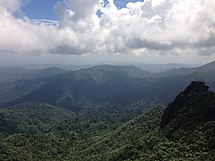Flora and fauna

Further information: Fauna of the United States: territories
The territories of the United States have many plant and animal species found nowhere else in the United States. All U.S. territories have tropical climates and ecosystems.
Forestsedit
The USDA says the following about the U.S. territories (plus Hawaii):
The U.S. territories, plus Hawaii include virtually all the Nation's tropical forests as well as other forest types including subtropical, coastal, subalpine, dry limestone, and coastal mangrove forests. Although distant from America's geographic center and from each other—and with distinctive flora and fauna, land use history, and individual forest issues—these rich and diverse ecosystems share a common bond of change and challenge.
Forests in the U.S. territories are vulnerable to invasive species and new housing developments. El Yunque National Forest in Puerto Rico is the only tropical rain forest in the United States National Forest system.
American Samoa has 80.84% forest cover and the Northern Mariana Islands has 80.37% forest cover—these are among the highest forest cover percentages in the United States (only Maine and New Hampshire are higher).note
Birdsedit
See also: Birds of American Samoa, Birds of Guam, Birds of the Northern Mariana Islands, Birds of Puerto Rico, Birds of the U.S. Virgin Islands, Birds of the U.S. Minor Outlying Islands, and List of birds of the United States
U.S. territories have many bird species that are endemic (not found in any other location).
Introduction of the invasive brown tree snake has harmed Guam's native bird population—nine of twelve endemic species have become extinct, and the territorial bird (the Guam rail) is extinct in the wild.
Puerto Rico has several endemic bird species, such as the critically endangered Puerto Rican parrot, the Puerto Rican flycatcher, and the Puerto Rican spindalis. The Northern Mariana Islands has the Mariana swiftlet, Mariana crow, Tinian monarch and golden white-eye (all endemic). Birds found in American Samoa include the many-colored fruit dove, the blue-crowned lorikeet, and the Samoan starling.
The Wake Island rail (now extinct) was endemic to Wake Island, and the Laysan duck is endemic to Midway Atoll and the Northwest Hawaiian Islands. Palmyra Atoll has the second-largest red-footed booby colony in the world, and Midway Atoll has the largest breeding colony of Laysan albatross in the world.
The American Birding Association currently excludes the U.S. territories from their "ABA Area" checklist.
Other animalsedit
See also: Mammals of American Samoa, Mammals of Guam, Mammals of the Northern Mariana Islands, Mammals of Puerto Rico, Mammals of the U.S. Virgin Islands, Mammals of the U.S. Minor Outlying Islands, Reptiles of American Samoa, Reptiles of Puerto Rico, Fauna of Puerto Rico, and Fauna of the U.S. Virgin Islands
American Samoa has several reptile species, such as the Pacific boa (on the island of Ta‘ū) and Pacific slender-toed gecko. American Samoa has only a few mammal species, such as the Pacific (Polynesian) sheath-tailed bat, as well as oceanic mammals such as the Humpback whale. Guam and the Northern Mariana Islands also have a small number of mammals, such as the Mariana fruit bat; oceanic mammals include Fraser's dolphin and the Sperm whale. The fauna of Puerto Rico includes the common coquí (frog), while the fauna of the U.S. Virgin Islands includes species found in Virgin Islands National Park (including 302 species of fish).
American Samoa has a location called Turtle and Shark which is important in Samoan culture and mythology.
Protected areasedit
There are two National Parks in the U.S. territories: the National Park of American Samoa, and Virgin Islands National Park. There are also National Natural Landmarks, National Wildlife Refuges (such as Guam National Wildlife Refuge), El Yunque National Forest in Puerto Rico, and the Pacific Remote Islands Marine National Monument (which includes the U.S. Minor Outlying Islands).
Comments
Post a Comment